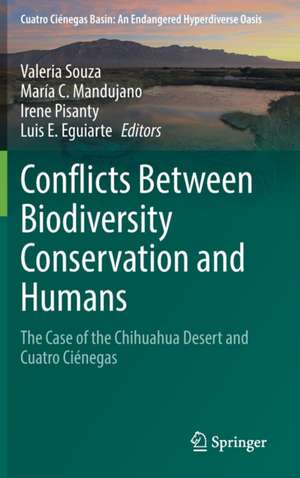Conflicts Between Biodiversity Conservation and Humans: The Case of the Chihuahua Desert and Cuatro Ciénegas: Cuatro Ciénegas Basin: An Endangered Hyperdiverse Oasis
Editat de Valeria Souza, María C. Mandujano, Irene Pisanty, Luis E. Eguiarteen Limba Engleză Hardback – 4 ian 2022
| Toate formatele și edițiile | Preț | Express |
|---|---|---|
| Paperback (1) | 913.41 lei 6-8 săpt. | |
| Springer International Publishing – 5 ian 2023 | 913.41 lei 6-8 săpt. | |
| Hardback (1) | 919.09 lei 6-8 săpt. | |
| Springer International Publishing – 4 ian 2022 | 919.09 lei 6-8 săpt. |
Preț: 919.09 lei
Preț vechi: 1120.83 lei
-18% Nou
Puncte Express: 1379
Preț estimativ în valută:
175.90€ • 185.57$ • 146.59£
175.90€ • 185.57$ • 146.59£
Carte tipărită la comandă
Livrare economică 03-17 ianuarie 25
Preluare comenzi: 021 569.72.76
Specificații
ISBN-13: 9783030832698
ISBN-10: 3030832694
Pagini: 191
Ilustrații: XVI, 191 p. 63 illus., 56 illus. in color.
Dimensiuni: 155 x 235 mm
Greutate: 0.47 kg
Ediția:1st ed. 2022
Editura: Springer International Publishing
Colecția Springer
Seria Cuatro Ciénegas Basin: An Endangered Hyperdiverse Oasis
Locul publicării:Cham, Switzerland
ISBN-10: 3030832694
Pagini: 191
Ilustrații: XVI, 191 p. 63 illus., 56 illus. in color.
Dimensiuni: 155 x 235 mm
Greutate: 0.47 kg
Ediția:1st ed. 2022
Editura: Springer International Publishing
Colecția Springer
Seria Cuatro Ciénegas Basin: An Endangered Hyperdiverse Oasis
Locul publicării:Cham, Switzerland
Cuprins
Preface.- 1 A land of illusions and thin air.- 2 The cosmovision of the ancient inhabitants of the desert, a look through the cave painting.- 3 Life in Cuatro Ciénegas, a historical tour of the Coahuila desert between the XVI and XIX centuries, its people, and their relationship with the environment.- 4 Water as a socializing element. Hydraulic culture in New Spain between the 16th and the 18th centuries.- 5 Environmental conservation, water and wetland governance in Mexico.- 6 Cuatro Ciénegas, an aquifer at risk of overexploitation.- 7 Demise of Churince.- 8 Plants as a canary in the mine: A wetland response to ecosystem failure.- 9 Can bacterial populations go extinct? Evolutionary biology and bacterial studies in Cuatro Ciénegas shed light on the extinction process.- 10 Children can save the world, CBTa 22, Rural High school as a social experiment for a sustainable future.- 11 Conservation of the most diverse oasis of the world and the future of our path in the deserts: Lessonsfrom Cuatro Ciénegas to the world.- Index.
Notă biografică
Valeria Souza has a bachelor’s degree in Biology, master’s degree in Genetics and PhD in Ecology from the National Autonomous University of Mexico (UNAM). In 1990 Valeria worked with Rich Lenski at Irvine California (UCI), where she gained experience in experimental evolution. In 1993, she took on a research position at UNAM in Mexico, where she still works today. She was one of the first researchers worldwide to study the evolutionary ecology of microbes. In 1999, Valeria and Dr. Eguiarte were invited by NASA to explore a new world on an expedition that led them to study microbial biodiversity in an unlikely oasis in the Chihuahuan desert. She is an international honorary member of the American Academy of Arts and Sciences.
Luis E. Eguiarte studied Biology at the School of Sciences (Facultad de Ciencias) of the National Autonomous University of Mexico (UNAM), where he completed his PhD in Ecology in 1990. He subsequently did a postdoc at the Department of Botany and Plant Sciences, University of California at Riverside, under the direction of Professor Michael Clegg. He joined UNAM as an Associate Professor in 1992, and is currently a professor at its Department of Evolutionary Ecology. In 2011 he was awarded the Faustino Miranda Medal by the Institute of Ecology, UNAM, in recognition of his outstanding academic contributions to Ecology. In his research, he studies the evolutionary and ecological mechanisms that generate diversity and adaptation in different organisms, in addition to conservation genetics and the domestication of Mexican plants. He has studied these problems in plants (including Agave, Abies, Bursera, Cucurbita and Zea), in bacteria, in particular in Cuatro Ciénegas, Coahuila, in the Chihuahuan desert, and in various species of mammals and birds, using modern genetic and statistical methods and genomic data.
Textul de pe ultima copertă
This book takes readers on a journey through the history of water in the Coahuila desert. It starts by describing the beauty and mysteries of the landscape, and then explores the rock art of the original desert cultures in Coahuila, offering readers a glimpse of the sacred nature of water in the desert, as well as the rituals surrounding it. Moving on to the colonial times and the post- independence development of the region, it discusses early water management, and explores how water is managed in modern times, as well as the legal complications of the law, and how these faulty laws, designed for less arid regions, have affected a highly diverse wetland, the Cuatro Ciénegas oasis. The book then examines the biological consequences of the water loss for the aquatic plants and animals in Churince – a now extinct system within Cuatro Ciénegas. Further, it addresses how even bacteria can become extinct in this hyper-diverse microbial oasis. Lastly, after this despair and sense of loss, the book provides hope, offering suggestions for how we can transform the future, from a social and educational point of view as well as through good science and changes in policy.
Caracteristici
This is the first book that focus on the problem of water in the desert of Mexico This book explains the historical and social reasons for its disappearance The book explores not only the problem but also gives hope for the future through education and change in policy






